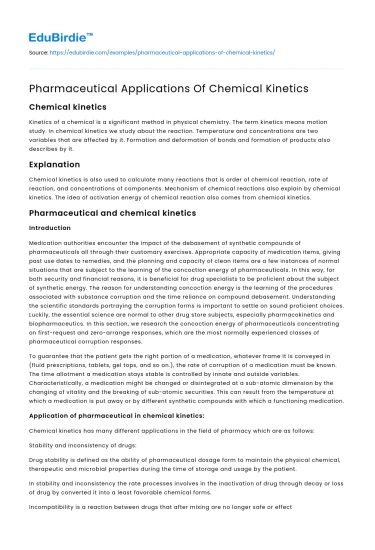Chemical kinetics
Kinetics of a chemical is a significant method in physical chemistry. The term kinetics means motion study. In chemical kinetics we study about the reaction. Temperature and concentrations are two variables that are affected by it. Formation and deformation of bonds and formation of products also describes by it.
Explanation
Chemical kinetics is also used to calculate many reactions that is order of chemical reaction, rate of reaction, and concentrations of components. Mechanism of chemical reactions also explain by chemical kinetics. The idea of activation energy of chemical reaction also comes from chemical kinetics.
Save your time!
We can take care of your essay
- Proper editing and formatting
- Free revision, title page, and bibliography
- Flexible prices and money-back guarantee
Pharmaceutical and chemical kinetics
Introduction
Medication authorities encounter the impact of the debasement of synthetic compounds of pharmaceuticals all through their customary exercises. Appropriate capacity of medication items, giving past use dates to remedies, and the planning and capacity of clean items are a few instances of normal situations that are subject to the learning of the concoction energy of pharmaceuticals. In this way, for both security and financial reasons, it is beneficial for drug specialists to be proficient about the subject of synthetic energy. The reason for understanding concoction energy is the learning of the procedures associated with substance corruption and the time reliance on compound debasement. Understanding the scientific standards portraying the corruption forms is important to settle on sound proficient choices. Luckily, the essential science are normal to other drug store subjects, especially pharmacokinetics and biopharmaceutics. In this section, we research the concoction energy of pharmaceuticals concentrating on first-request and zero-arrange responses, which are the most normally experienced classes of pharmaceutical corruption responses.
To guarantee that the patient gets the right portion of a medication, whatever frame it is conveyed in (fluid prescriptions, tablets, gel tops, and so on.), the rate of corruption of a medication must be known. The time allotment a medication stays stable is controlled by innate and outside variables. Characteristically, a medication might be changed or disintegrated at a sub-atomic dimension by the changing of vitality and the breaking of sub-atomic securities. This can result from the temperature at which a medication is put away or by different synthetic compounds with which a functioning medication.
Application of pharmaceutical in chemical kinetics:
Chemical kinetics has many different applications in the field of pharmacy which are as follows:
Stability and Inconsistency of drugs:
Drug stability is defined as the ability of pharmaceutical dosage form to maintain the physical chemical, therapeutic and microbial properties during the time of storage and usage by the patient.
In stability and inconsistency the rate processes involves in the inactivation of drug through decay or loss of drug by converted it into a least favorable chemical forms.
Incompatibility is a reaction between drugs that after mixing are no longer safe or effective for the patient.
Characteristics of incompatibility include
- Color change
- Hazy appearance
- Precipitation
Dissolution of drugs
The adequacy of an oral measurement shape relies on the inherent capacity of the medication to disintegrate in the liquids of the gastrointestinal tract before being consumed into the flow. In this manner, the rate of disintegration of the tablet or container is vital to this procedure.
The correct disintegration system utilized is controlled by the measurement frame qualities and the proposed course of organization.
Absorption of drugs
Medication assimilation is dictated by the medication's physicochemical properties, plan, and course of organization. Dose frames (e.g, tablets, containers, arrangements), comprising of the medication in addition to different fixings, are planned to be given by different courses (e.g, oral, buccal, sublingual, rectal, parenteral, topical, inhalational). Notwithstanding the course of organization, drugs must be in solution for be ingested. Accordingly, strong structures (e.g, tablets) must most likely deteriorate and disaggregate.
Drugs action
In pharmacology, the term mechanism of activity (MOA) alludes to the particular biochemical communication through which a medication substance creates its pharmacological impact. A system of activity for the most part incorporates notice of the particular sub-atomic focuses to which the medication ties, for example, a chemical or receptor.
Chemical Kinetics in food industry
We use chemical reactions in food during the process of storage. We use different chemicals for storage of food. Some reactions involves to decrease the quality of food. Whereas other reactions are used to produce flavor and color in food.
So basically, chemical kinetics involves in storage and provide color to food. Different reactions do different mechanism and produces different results. Chemical kinetics tell us how to preserve food with different reactions. Many reaction spoiled the quality of food as well as most of reaction use for coloration of food.
Maillard reaction
Maillard reaction is very important in manufacturing of food. In this reaction the involvement of enzyme does not take place. It is used to prepare some types of food.
In this type of reaction the group of carbonyl compound reacts with amino acid group for the production of glycosylamine and a molecule of water. After the rearrangement of this compound we get a compound known as ketosamine. Ketosamine is used to prepare different kinds of products.
The rate of reaction involves to tell us about the reactions produces in products. These reactions involves to produces flavor in products. It is very important for industries to control the milliard reaction to produces better flavor in the products.






 Stuck on your essay?
Stuck on your essay?

